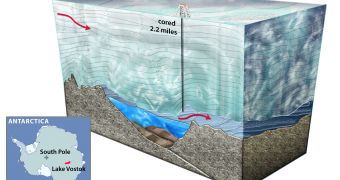It seems that life really can't survive everywhere, or at the very least that it's hard to find in some places. Russian scientists have published the first preliminary results of their drilling into Lake Vostok, several kilometers beneath the Antarctic ice, show the lake, which has been sealed off for at least 15 million years, maybe more, to be devoid of life.
Lake Vostok is a large pool of liquid water way beneath the Antarctic ice surface. Russian scientists have been boring for years through 3,623 m, 2.25 miles of ice to get to the water and finally managed to do it last February.
They were able to get some samples before the weather became too cold for any more drilling.
Scientists are looking for extremophiles, forms of life that survive or even thrive in extreme environments, like deep beneath the ocean, in extremely hot or acidic environments that would kill most organisms on Earth.
Now that the samples have been analyzed, the results are disappointing, the little microbial life that was found comes from the drilling and is not native to the lake.
The hope was that finding life in this extreme environment would prove that life could exist in other such places, notably on other planets or moons in the Solar System, like Jupiter's Europa or even Saturn's Titan.
However, while the initial results are disappointing, there's no reason to believe that the lake is indeed completely devoid of life.
The samples so far are from the very top of the lake and the method for their extractions wasn't ideal. For one, many people were worried about contaminating the samples, due to the drilling process.
Second, the water the Russians got from the top of the lake froze on its way up. This process can mean that most impurities in it, including microorganisms, would be left out, 99 percent of impurities are not retained when water freezes.
So even the top of the lake could contain life, but there need to be better sampling methods. What's more, the bigger hope is that life could be found deeper inside the lake.
The lake is estimated to be as much as 900 m / 3,000 feet deep in places and there's a layer of sediment several hundreds of meters deep below that. It is more likely that life, if it exists, would be found deeper into the water or in the sediment layer.
Drilling will start again in December and results from this second try will be in by May 2013.

 14 DAY TRIAL //
14 DAY TRIAL //